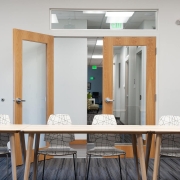The flexible workspace industry has seen explosive growth year over year that will continue to grow. What started as spaces for freelancers & digital nomads have become mainstays for the workforce, including the largest global companies.
Part 4 of this series delves into why larger companies should leverage the flexible workspace movement. If you haven’t read the previous entries, here are links to each:
- Part 1 provided an overview of the coworking industry and its potential in the future.
- Part 2 focused on the benefits for individual members & the ecosystem of workspaces that exist today, including coworking spaces.
- Part 3 was all about the opportunity for commercial real estate to grow the flexible workspace industry.
Large companies & corporations are driving a major portion of the growth in the flexible workspace industry, expected to create 40% of the demand for flexible workspace in the coming years. Flexible work policies & distributed teams are becoming the rule rather than the exception. Professional office space is still needed wherever those employees are, whether its full teams or single remote employees.
Employers & HR managers can leverage the growing coworking industry as part of a competitive strategy to attract, retain, and support talent. The value proposition of coworking for employers is just as strong as it is for individual workers.
What are some of the benefits of coworking for a large business?
Flexibility, not only in schedules, but in how & where work is done, is key for developing & maintaining a competitive & productive workforce. Coworking spaces can play a significant role in helping companies achieve that flexibility for their employees.
For employees that are not on-site at a corporate headquarters, coworking spaces are fully amenitized workplaces ready to go when and where they are needed, in more and more communities across the globe. With flexible membership options and workspaces, coworking spaces are great alternatives to home offices or coffee shops for working remotely.
Additionally, companies can also benefit from the flexibility provided by coworking spaces. The amount of space occupied can be scaled up or down, without the need for a company to manage a complicated and expensive build out. Many coworking spaces can accommodate everything from a single desk user to a large team suite. Companies can lease out only the space they need, even if those needs change quickly.
Why are these benefits valuable to a business?
Office space is a big expense for companies, both in regards to capital & operational expenditures, and is not typically the primary focus of the business. Coworking spaces can help companies not only reduce expenses, but also get more value out of the space that is being used, while helping companies focus more time on what they need to, their business.
They are balance sheet friendly – Utilizing shorter term agreements for coworking and flexible office space instead of managing real estate leases in house reduces risk & complications for a business’ financial statements. With the implementation of new FASB lease accounting standard (ASC 842 & IFRS16), organizations are required to recognize leases as assets & liabilities on their balance sheets for any lease that is over 12 months. This standard went into effect on January 1, 2019 for public companies, and will apply to private and non-profit organizations as well starting in December of 2020.
They are a better use of resources – Many of us have either seen or experienced a large corporate office floor with almost no one using it. The ability to more accurately match real estate needs with headcount needs can result in a direct reduction of real estate expenses. Why pay for the space if your employees aren’t using it? A better use of resources is to pay for the space that is actually needed and where it will actually be used.
What are some of the problems being faced by HR Managers?
Talent attraction – Competition for talent is fierce. Finding & attracting high quality employees requires increasingly enticing offers. Only a portion of that comes down to salary. Many in today’s workforce are looking for flexibility, remote work opportunities, and good perks in addition to competitive financial incentives.
Productivity & Retention – Once a company has the talent, the next challenge is retaining them and supporting a work environment that contributes to high levels of productivity. For example, a workplace that requires a long commute can reduce job satisfaction in a similar way as a pay cut. That’s before an employee even makes it to the office for the day.
How does coworking solve these problems?
Distributed employees, distributed space – Recruiting can benefit from a broader geographic pool. Coworking provides office space for a company without the need to set up satellite office operations or requiring employees to relocate. Resources can be redirected from maintaining a large scale headquarters to coworking memberships & digital tools that can support remote & distributed teams.
Use of coworking spaces can be leveraged as a competitive edge for recruiting by illustrating a company’s support for flexibility in how & where an employee chooses to work. Flexible work is no longer a generous perk, but required for companies to maintain a talent advantage.
Improved employee experience, improved productivity – The statistics gathered over the last several years make a clear case for the benefits of working from an alternate work environment like a coworking space, such as:
- 84% of people who use coworking spaces are more engaged and motivated &
- 89% of people who cowork reported being happier.
Coworking spaces can help make people happier, which correlates to improved productivity, as discussed in our previous article on the 3/30/300 Rule of Thumb.
Why is coworking the best solution to these problems?
The demand for flexible work arrangements from the workforce will continue to grow. Flexibility and autonomy are what workers want. Companies that can provide that are rewarded with more productive, more satisfied, more loyal employees, ultimately saving money by avoiding lost productivity and employee churn.
If shifting away from the traditional corporate office to alternate work environments is the goal, why not have all their employees work from home and skip the office completely?
It’s not possible to implement effective remote or flexible work policies without providing your employees with the appropriate resources to be successful. Coworking is one of those resources – a professional work environment, others to work around, division between work and home life, and lots of coffee. Not everyone is productive or happy working from home. When workers can work at least part-time from an office environment, like a coworking space, they are more productive.
The flexibility that coworking spaces provide is a benefit to both the employees utilizing the space as well as the companies they work for.
The bottom line – coworking space for business is good for the bottom line.


